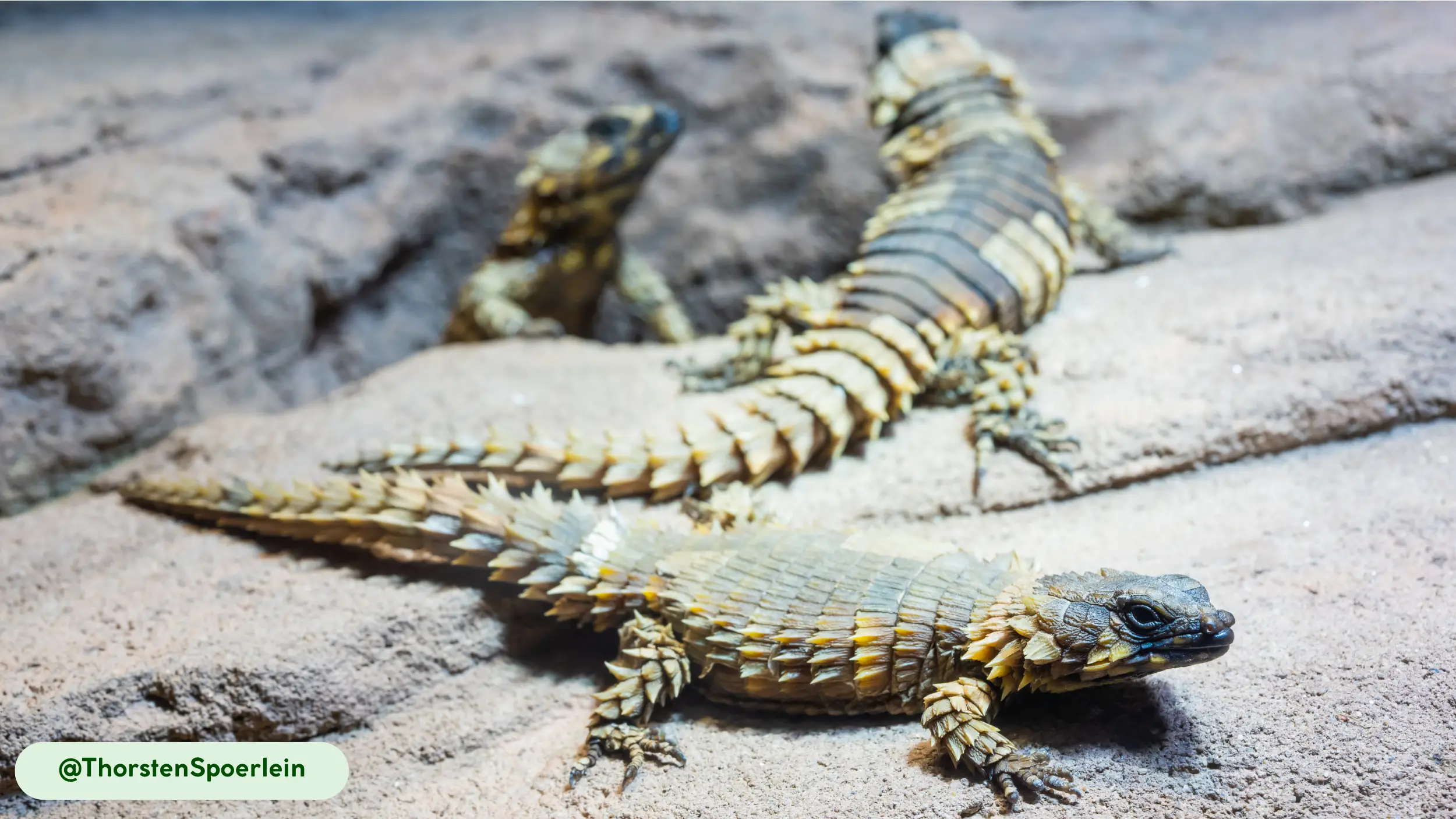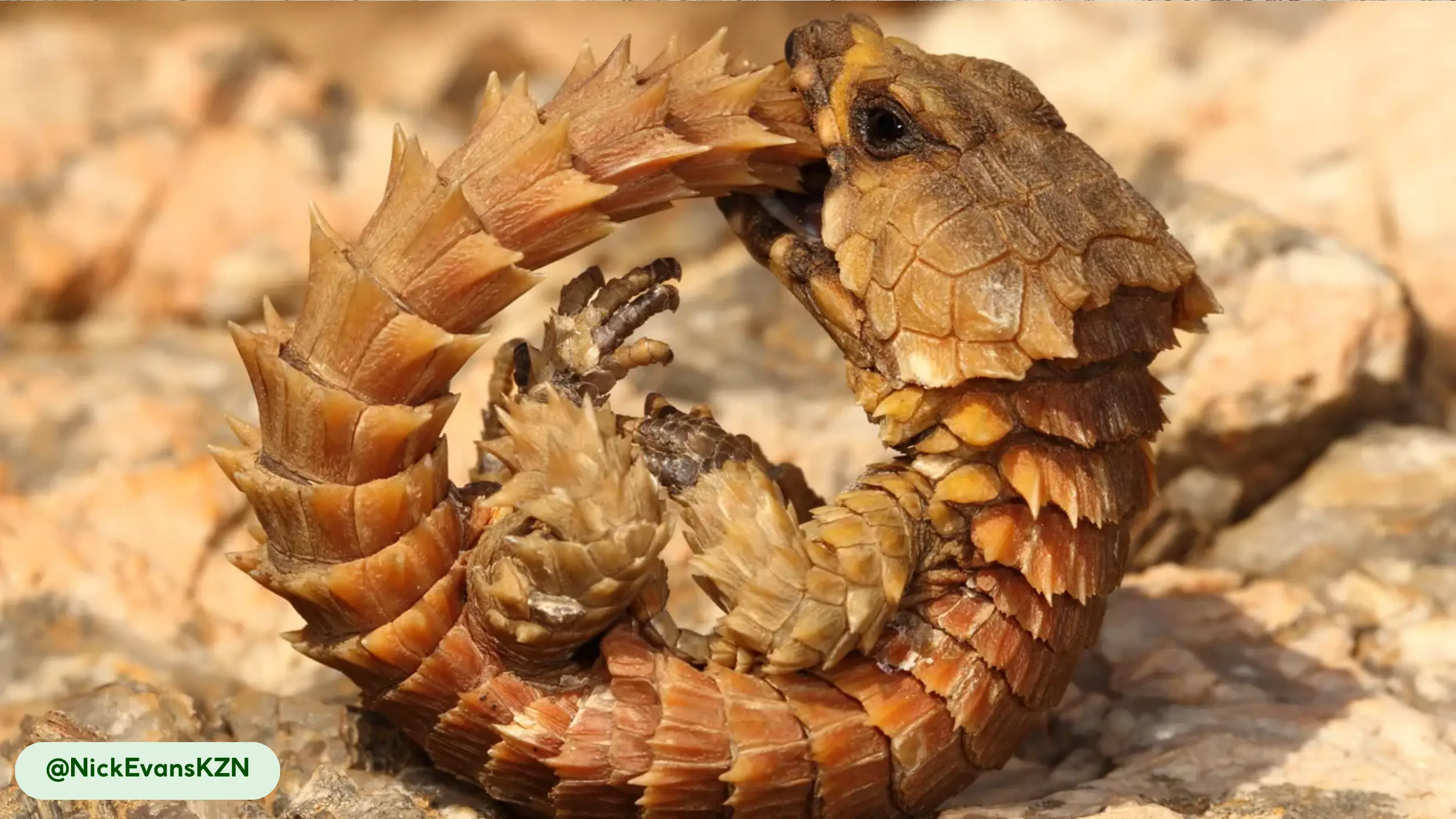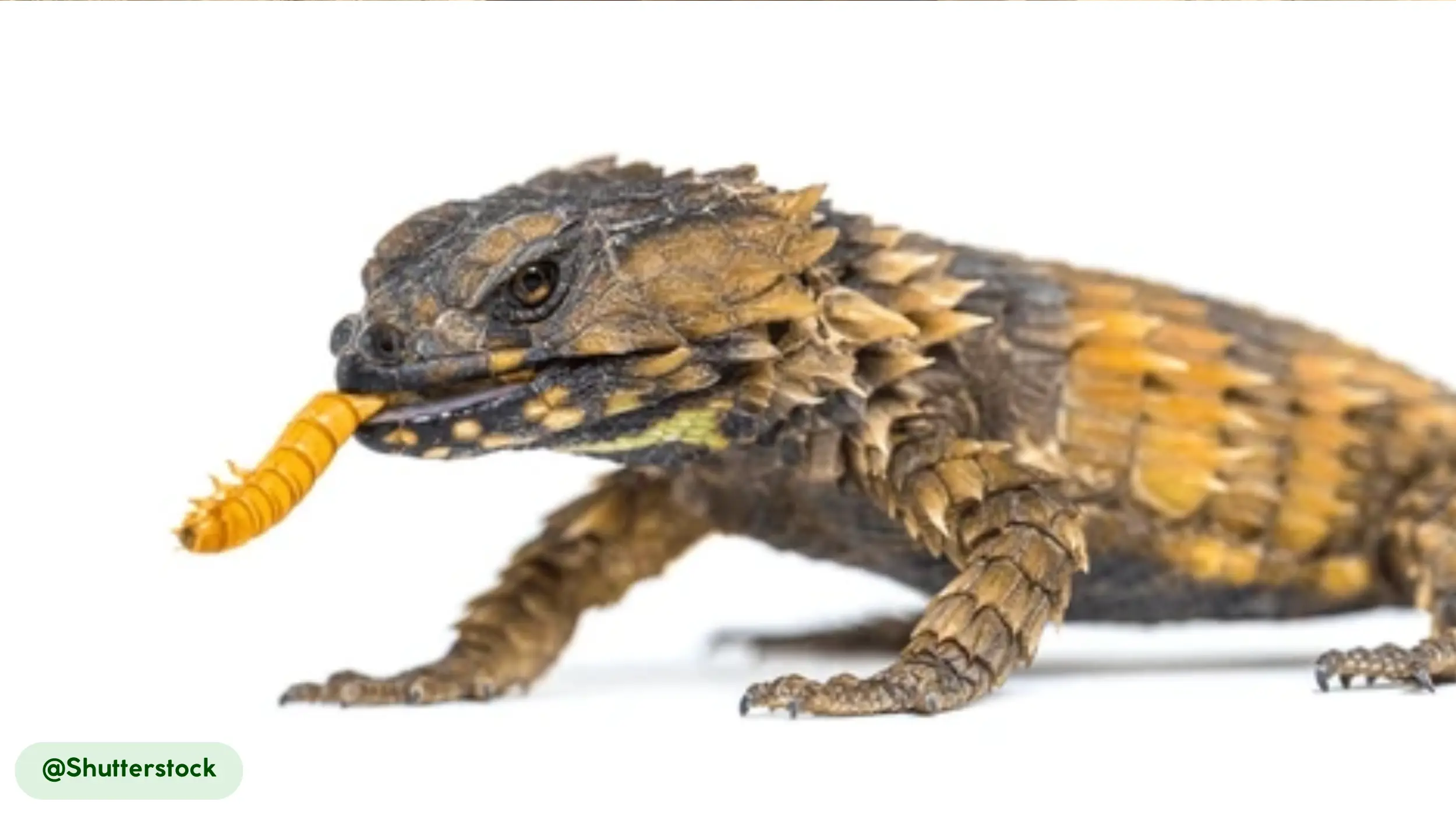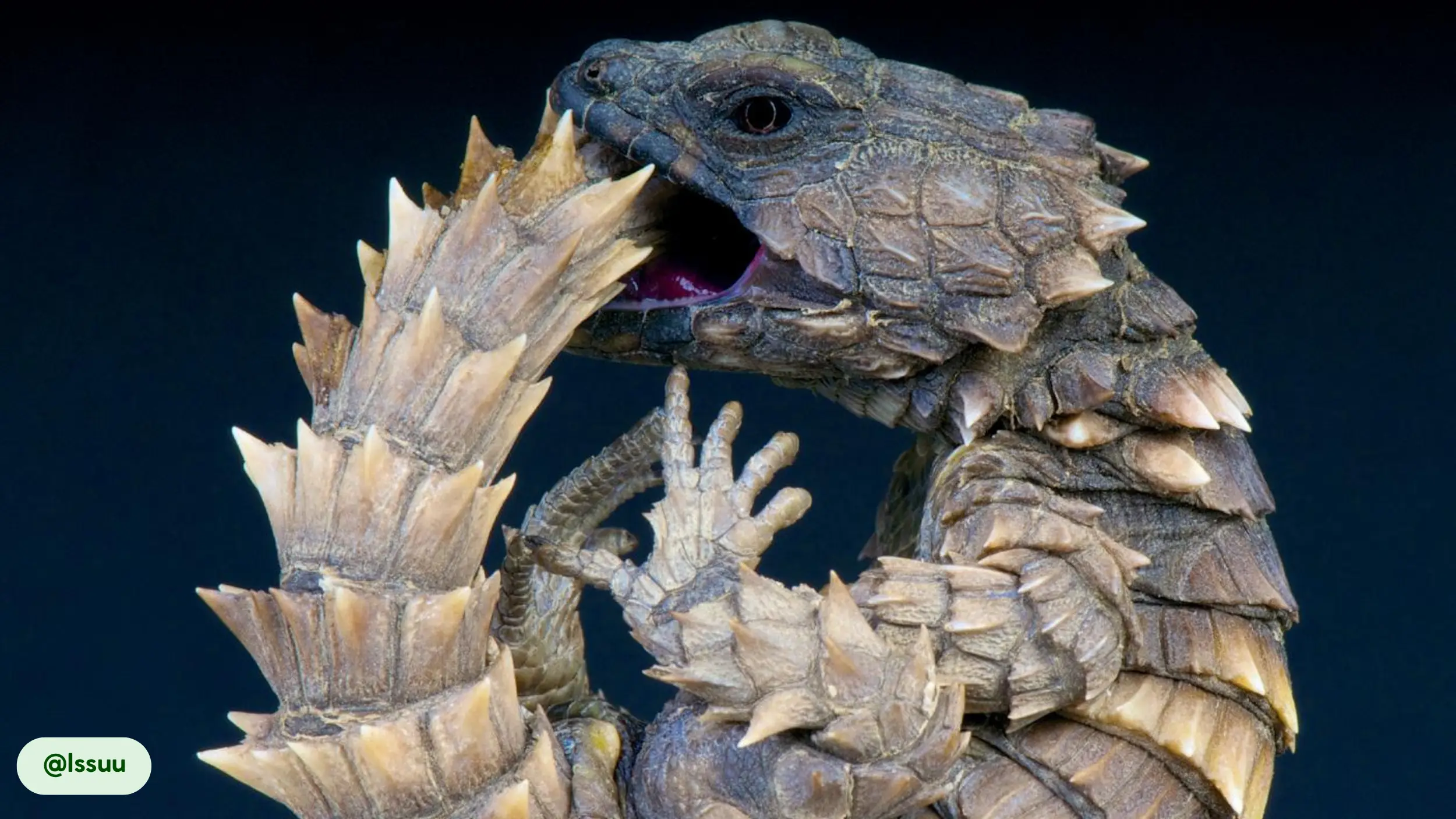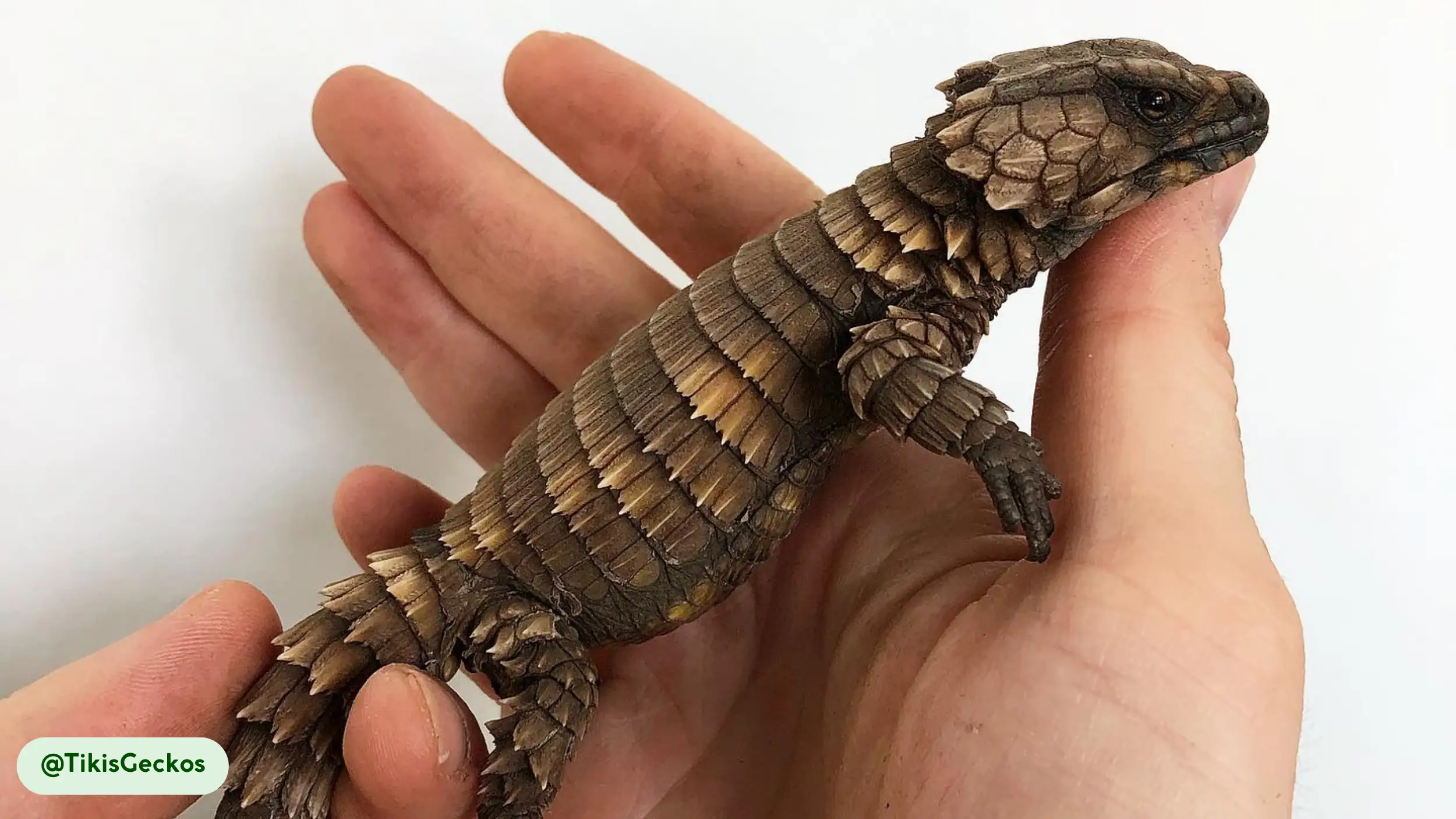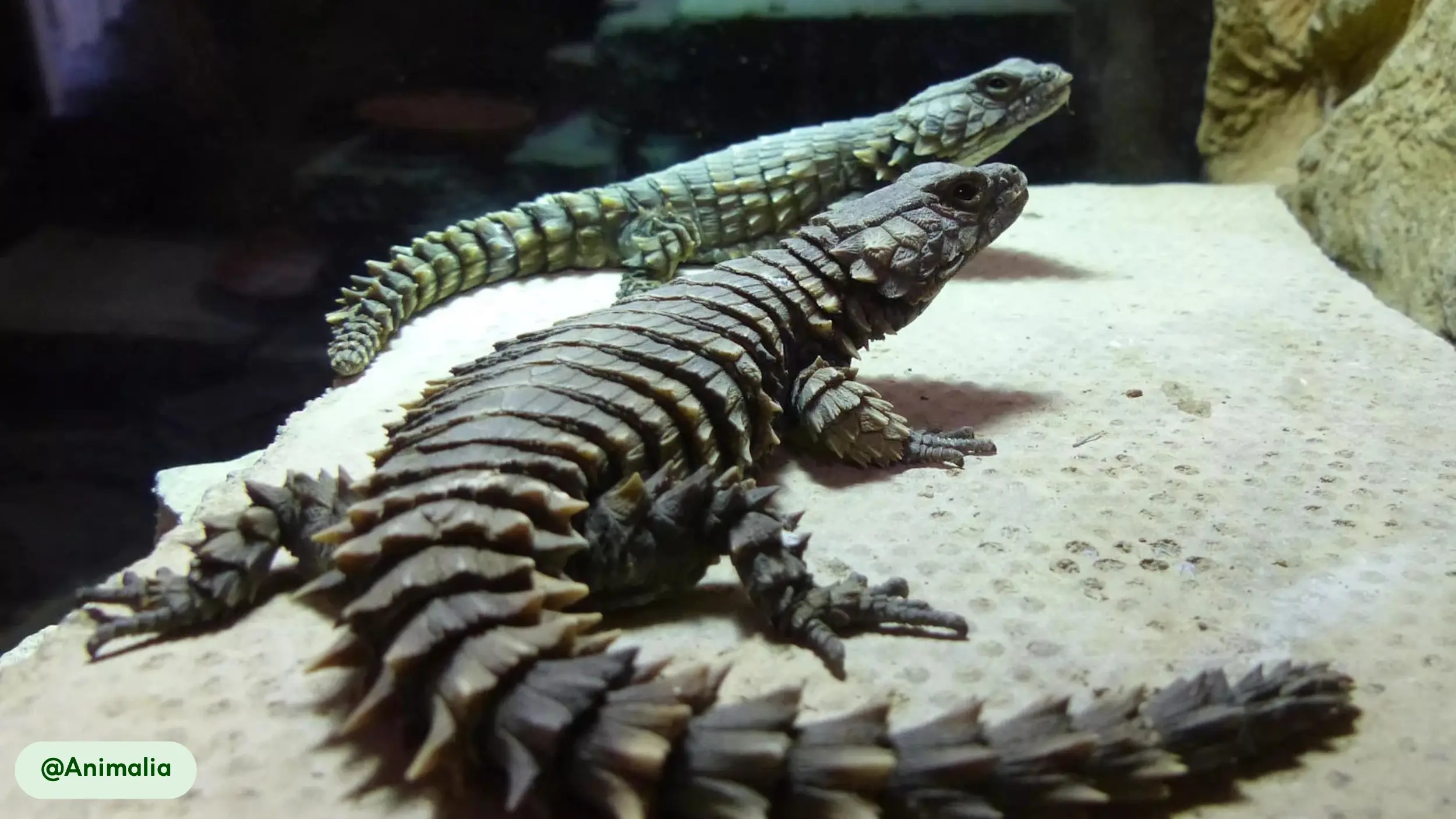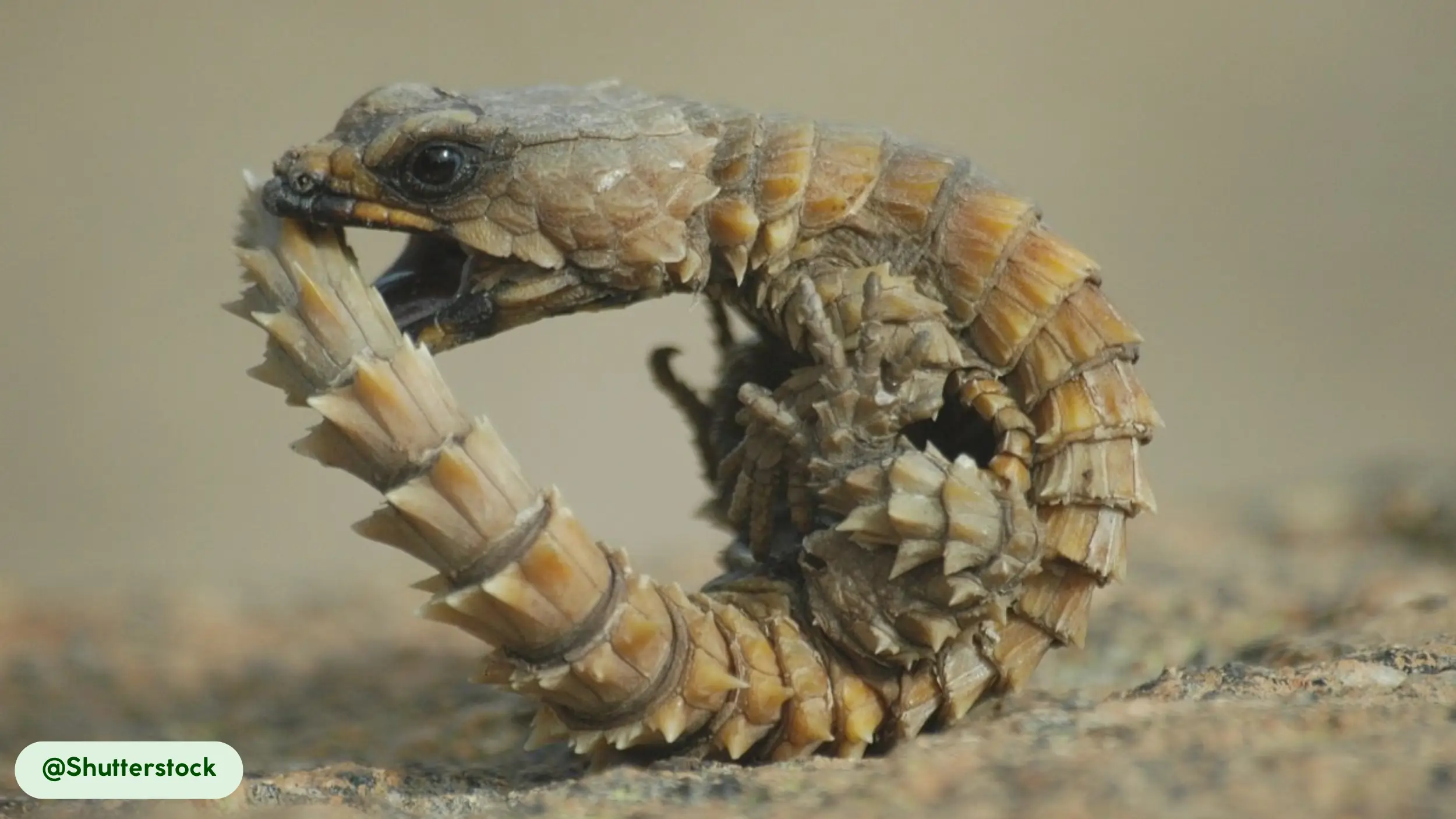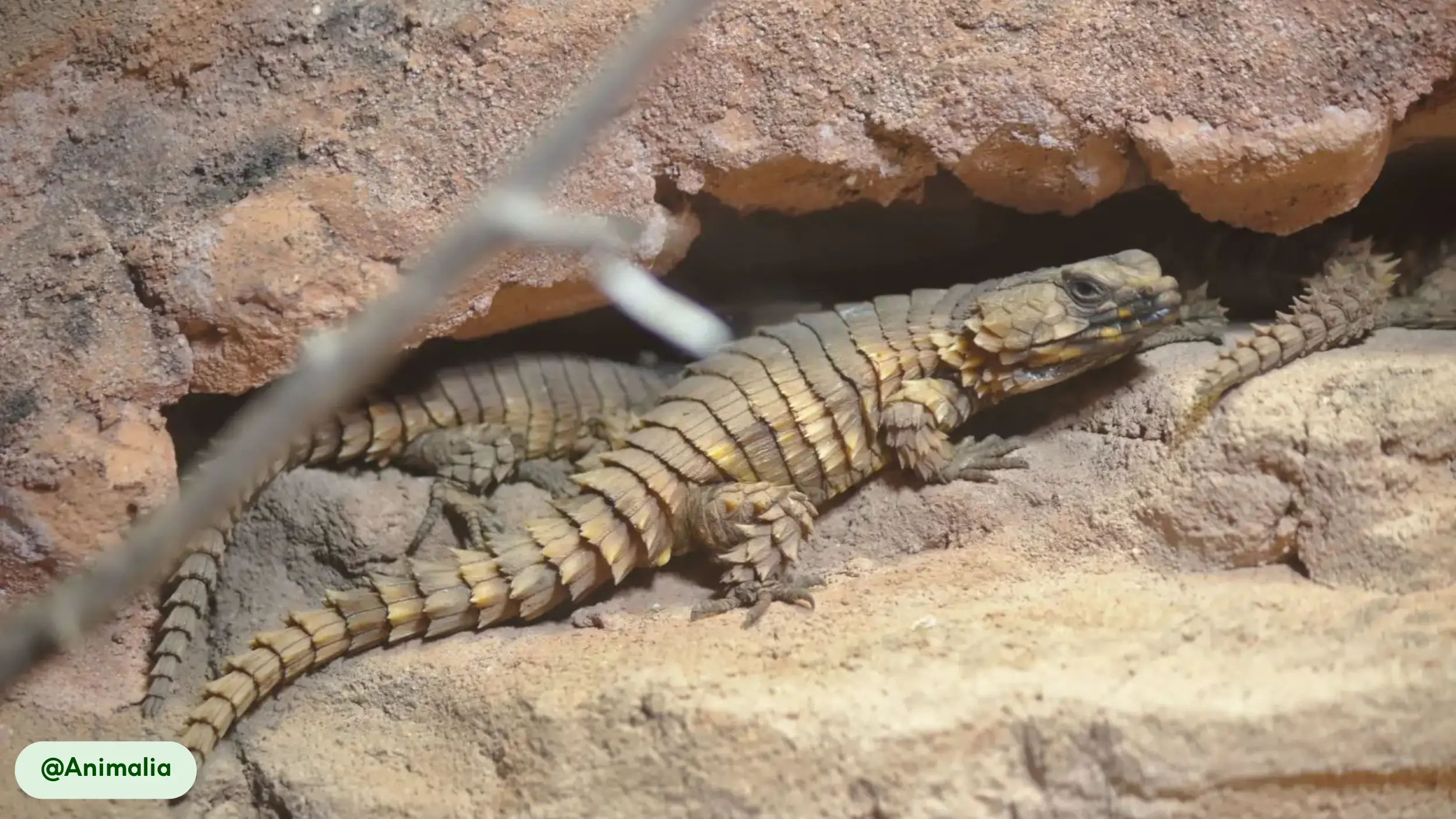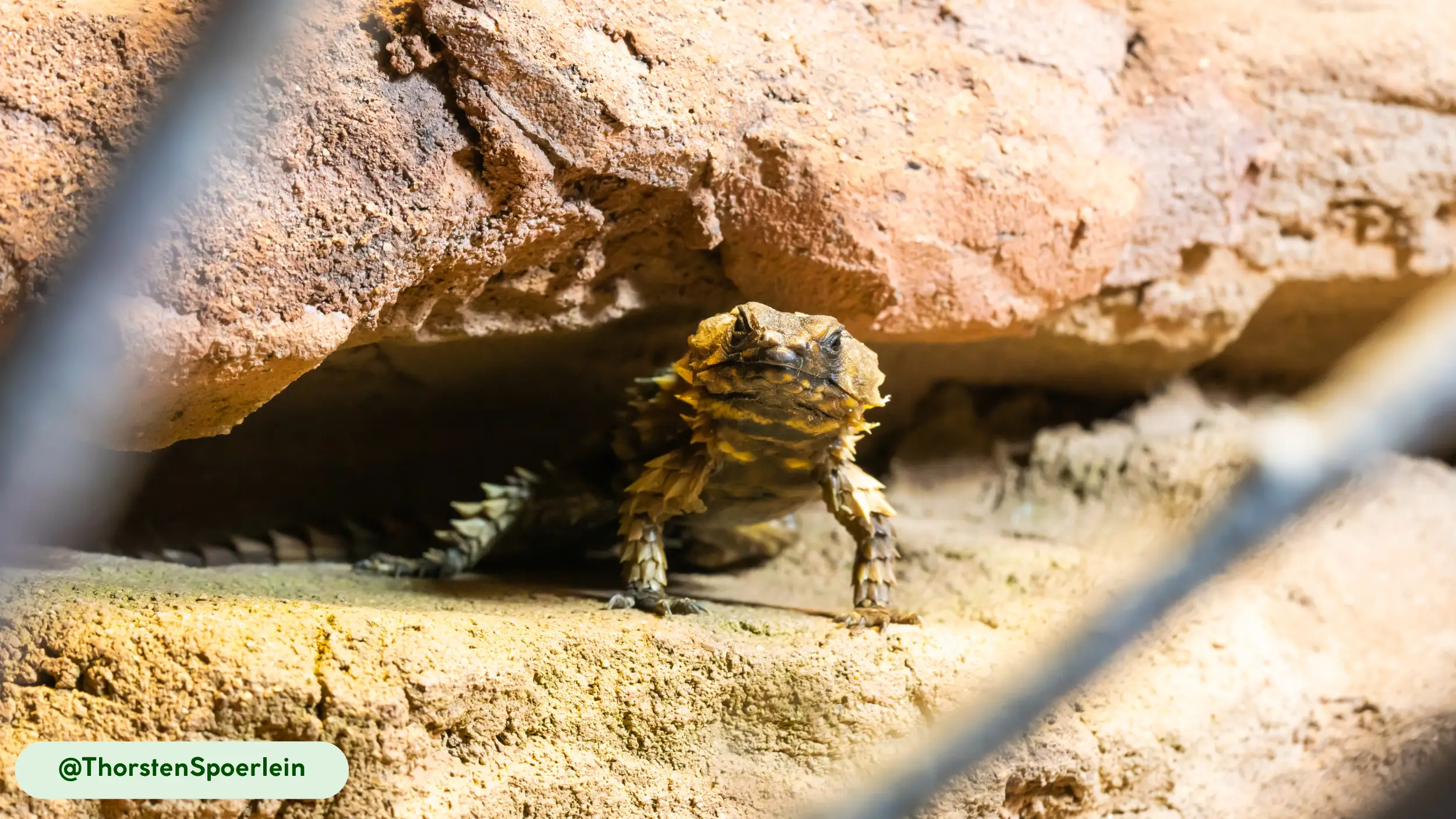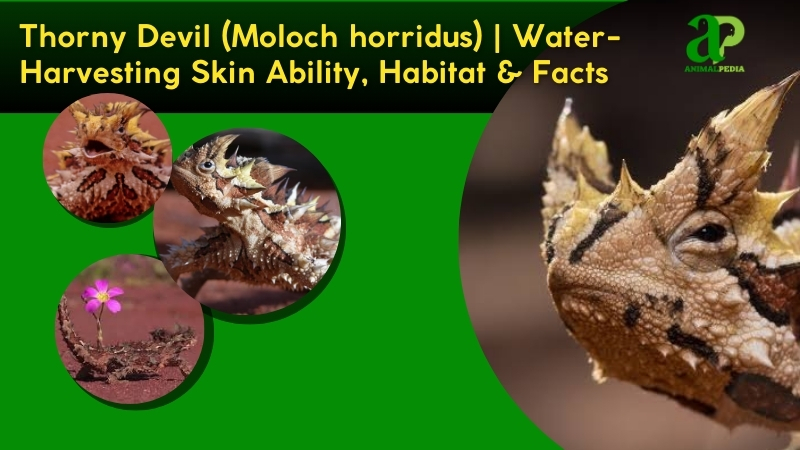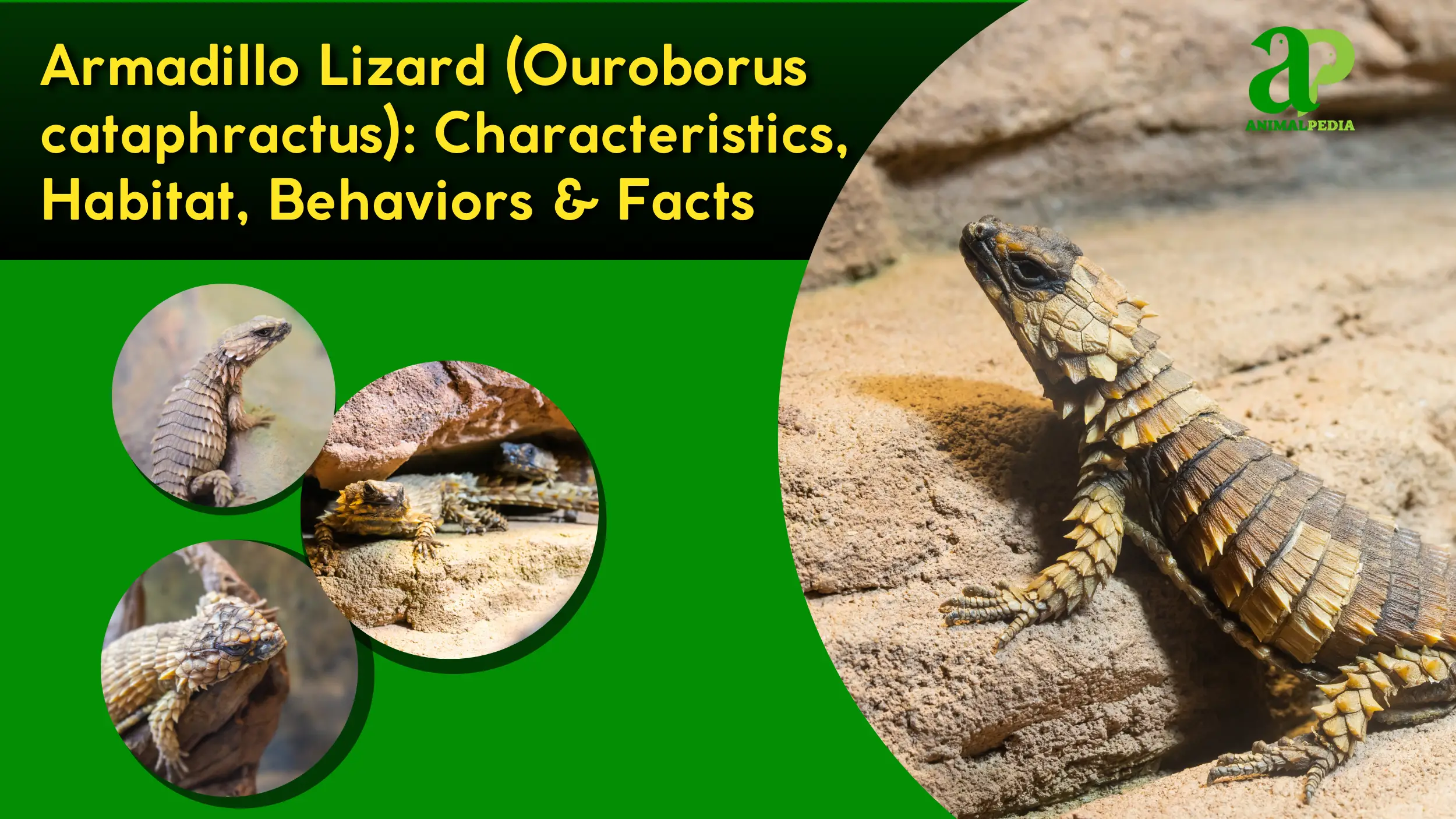Armadillo Girdled Lizards (cataphractus) are a unique species within the family Cordylidae, known for their distinct, armored appearance and defensive behaviors. These reptiles, found exclusively in the arid, rocky landscapes of South Africa’s Succulent Karoo biome, possess a squat, flattened physique with a body length of up to 8 inches (21 cm) and an average weight of 2.5-5 ounces (70-140 g).
The species is recognized for its peculiar defense mechanism, where it bites its own tail to form a tight, spiny ring, a posture that evokes the ancient mythological symbol of a snake eating its tail, the ouroboros.
This diurnal insectivore primarily consumes termites, which it captures by ambushing them near their mounds. The species faces threats from habitat loss and the illegal pet trade, leading the IUCN to classify it as Near Threatened.
The initial glimpse of the Armadillo Lizard’s world reveals its incredible survival strategies. To fully appreciate its place in the ecosystem, we must first understand the scientific background and evolutionary journey that shaped this species.
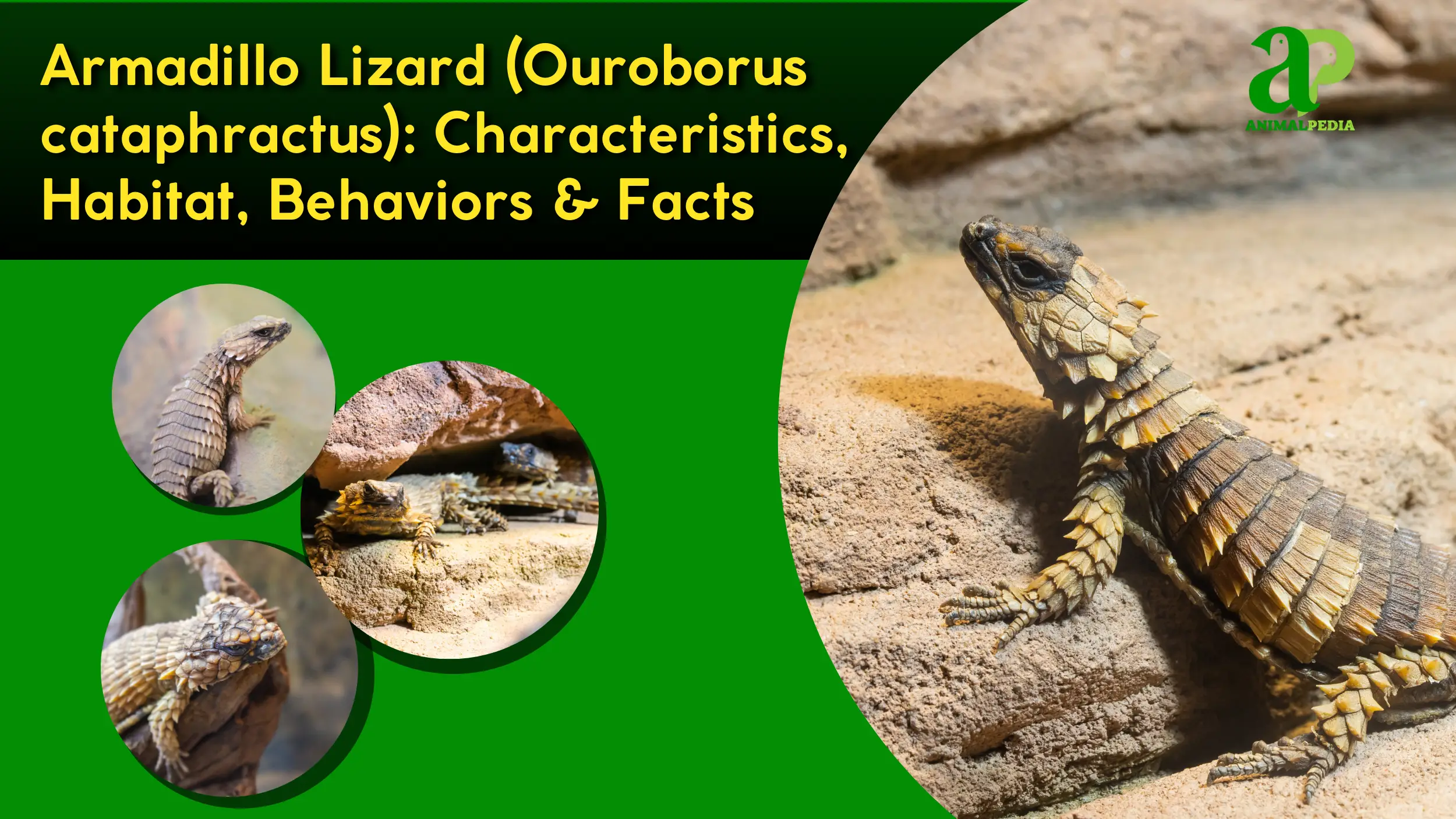
What Are Armadillo Lizards?
Armadillo Girdled Lizards are a species of small, spiny lizards endemic to the rocky, arid habitats of South Africa, notable for their unusual defensive practice of rolling into a ball [2][19]. Scientifically classified as Ouroborus cataphractus, this species belongs to the family Cordylidae, a group of lizards characterized by their bony, armored scales, and is a member of the broader order Squamata, which encompasses all scaled reptiles [2][6][11].
While the common name Armadillo Lizard is widely used, it is also known as the Golden Armadillo Lizard or Dragon Armadillo Lizard, names derived from its golden-brown scales and mythical appearance [1][2][19]. The genus name, Ouroborus, was established after a 2011 molecular phylogeny study revealed a 12-15% mitochondrial DNA divergence from other species in the formerly used genus, Cordylus [15][19].
This reclassification has been a point of contention within the scientific community; some researchers argue for a return to the original genus, citing shared morphological traits such as osteoderm structure and live-bearing reproduction [9][15]. The species, first described in 1828 by French naturalist F. Boie, stands as a prime example of a reptile that has evolved a specialized defense against predators [19].
The physical form of this lizard, with its distinctive armor and defensive curl, is truly a sight to behold. To grasp the full extent of these adaptations, it’s essential to examine the specific details of its appearance, from its armored scales to its powerful jaw.
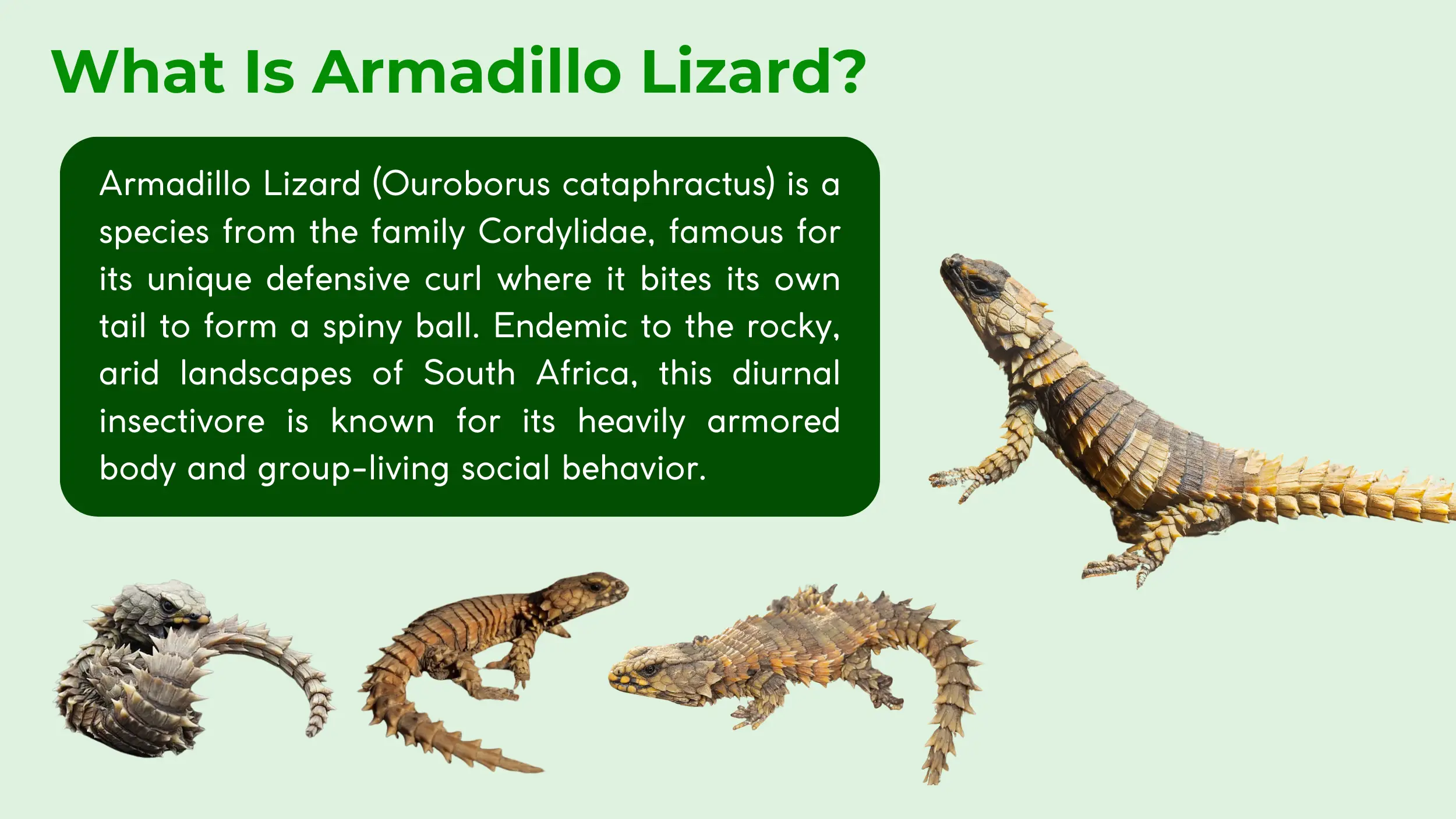
What Do Armadillo Lizards Look Like?
Armadillo Lizards possess a squat, flattened body structure with a distinctive, heavily armored hide that defines their appearance [1][2][19]. Their coloration ranges from a light to dark yellow-brown, with some individuals exhibiting a richer, golden-brown hue, which allows them to blend into the arid, rocky landscapes of their native South Africa [1][2].
The lizard’s entire body is covered in large, plate-like scales that are arranged in a regular, transverse pattern, providing both protection and a unique texture [2][17]. These scales are especially prominent on the head, back, and tail, where they form rows of powerful, projecting spines that serve as a deterrent to predators [2][17].
The head is broad and blunt, with a powerful jaw, and the limbs are short and muscular, designed for moving between and climbing on rocks [2][19]. Their body ends in a short, spiny tail that is a key component of their defensive display [2][19].
The physical attributes of the Armadillo Lizard are impressive, but they are just one part of its story. Understanding its size and scale helps to put its unique characteristics into perspective, painting a clearer picture of this animal’s life.
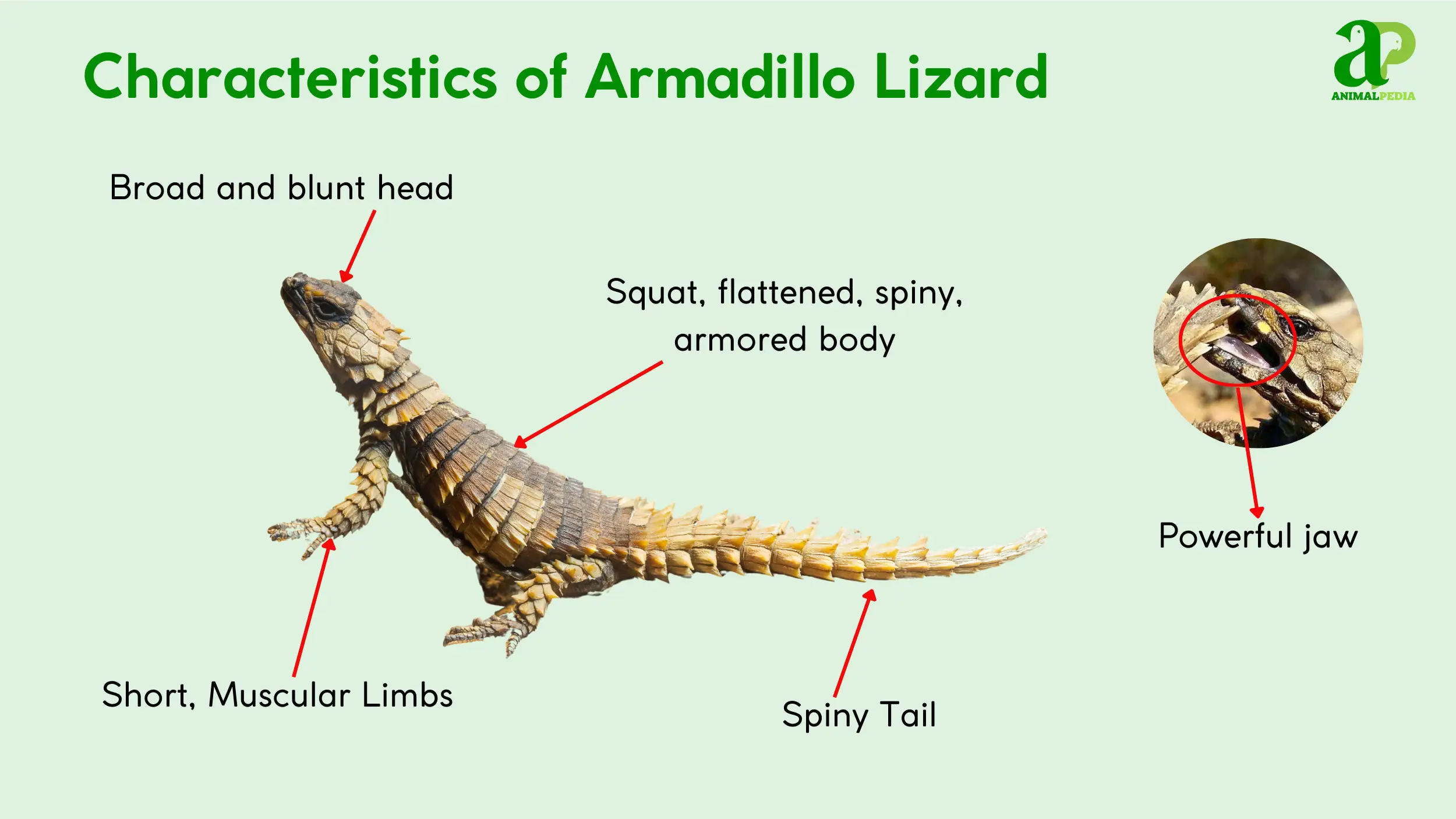
How Big Are Armadillo Lizards?
The average adult Armadillo Lizard measures approximately 6 to 8 inches (15 to 21 cm) in total length from snout to tail tip, with an average body weight ranging from 2.5 to 5 ounces (70 to 140 g) [2][19]. While this species exhibits minor sexual dimorphism, the size differences are subtle but present [2][19]. The following table highlights the typical size metrics for each sex.
| Metric | Male | Female |
| Average Length | 6.5 inches (16.5 cm) | 6.2 inches (15.7 cm) |
| Average Weight | 4 ounces (113 g) | 3.5 ounces (99 g) |
| Record Size | 8.5 inches (21.6 cm) | 8 inches (20.3 cm) |
Hatchlings are born small, typically measuring around 2.4 to 3.1 inches (6 to 8 cm) in length [2]. They gradually grow to their adult size over several years [2]. A full-grown adult Armadillo Lizard is roughly the size of a banana or a common house mouse [1][2].
While the lizard’s physical size is a key characteristic, it’s only one piece of the puzzle. The most fascinating aspect is its exclusive home in the rocky landscapes of South Africa, where every physical trait serves a specific purpose for survival.

Where Do Armadillo Lizards Live?
Armadillo Lizards are found exclusively in the arid, rocky landscapes of South Africa, with their primary distribution in the Western Cape and Northern Cape provinces [2][19].
Their natural habitat consists of the Succulent Karoo biome, an ecological region characterized by its high diversity of succulent plants and dry, semi-desert conditions [2]. The lizards are highly specialized to this environment, seeking refuge within the rocky outcrops and sandstone crevices that dot the hillsides and mountainsides [2].
This habitat selection is not random; the lizards’ group-living behavior, which offers benefits such as shared thermoregulation and vigilance, is directly influenced by the availability of suitable rock fissures [14]. They establish small territories centered around a communal crevice or den, which serves as a central point for a family group [14][19].
This close association with their specific rock formations means they are not found in the open plains of the Karoo but are confined to these stony habitats [2]. Their reliance on a specific type of microhabitat makes them particularly vulnerable to habitat destruction [12][16].
The Armadillo Lizard’s habitat has shaped its very existence, but its behaviors and social interactions are what truly define its day-to-day life. From hunting termites to sheltering in groups, its actions in the wild are a testament to its social and adaptive nature.

How Do Armadillo Lizards Behave?
Armadillo Lizards are highly social and are known for their distinct group-living behavior and specialized defensive posture [14]. Their daily routines and interactions are tailored to the demands of their arid, rocky environment.
- Diet and Feeding: This species is an insectivore that primarily consumes termites, hunting its prey through an ambush strategy near their burrows.
- Movement and Abilities: They move deliberately between rock crevices, using their muscular bodies for climbing and their armored scales for protection against threats.
- Daily/Seasonal Patterns: These diurnal lizards are active during the day, with behavior and activity levels that fluctuate with the seasons in their semi-desert habitat.
The daily routines of the Armadillo Lizard reveal how it has mastered its environment through complex social and survival strategies. This mastery extends to its reproductive cycle, a process that is surprisingly distinct from that of many other reptiles.
Diet and Feeding
The Armadillo Lizard is a specialized insectivore, with its diet consisting primarily of termites [2][19]. While they may also consume other small invertebrates such as spiders, caterpillars, and beetles, termites form the vast majority of their food intake [2].
As opportunistic foragers, they actively hunt during the warmer parts of the day when their prey is most active [14]. They will patiently wait near termite mounds and foraging trails before using a swift strike to capture their prey [2]. Their strong jaws and robust skull are adapted for crushing the hard exoskeletons of their insect prey [19].
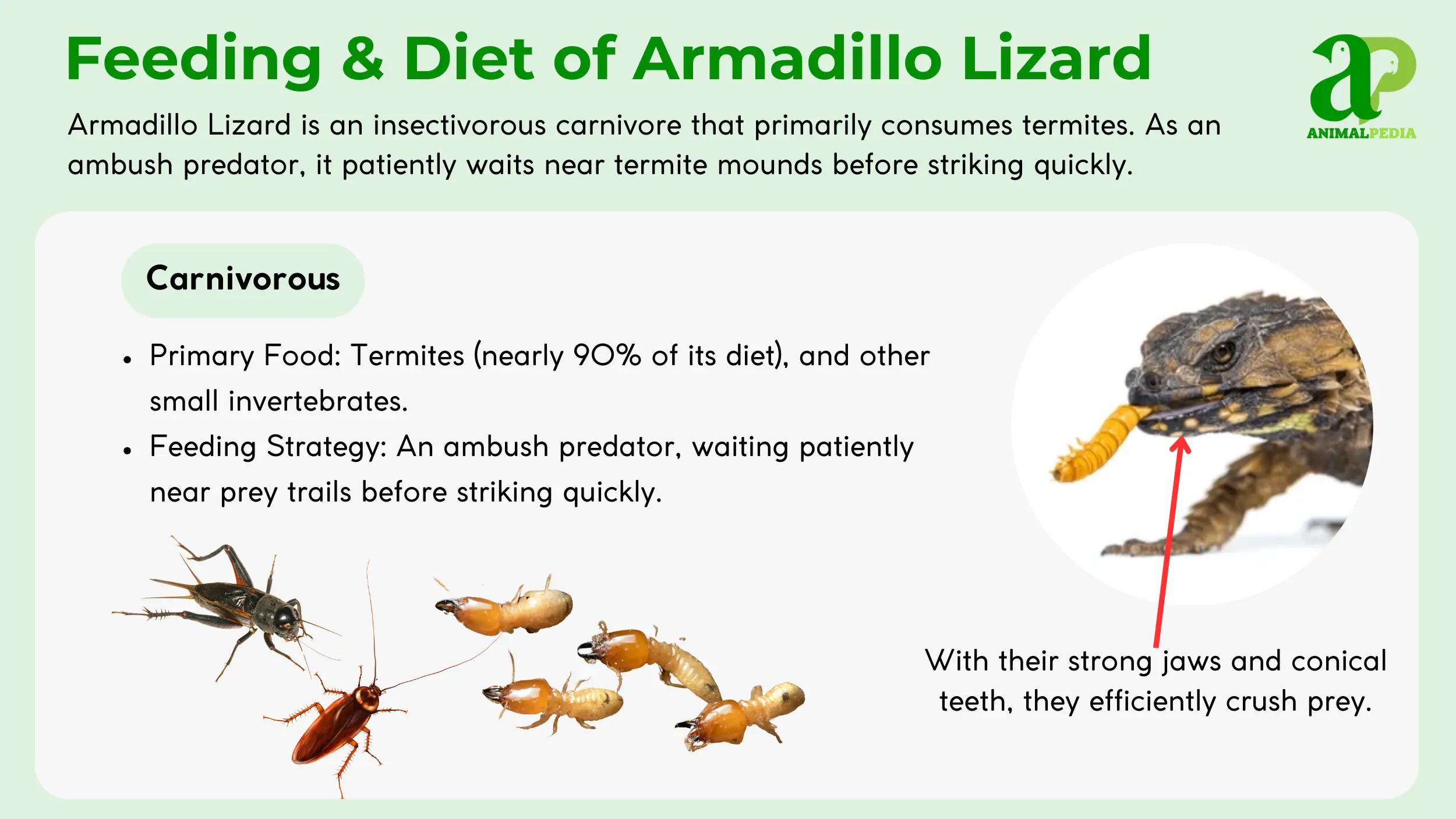
Movement and Abilities
Armadillo Lizards move with a deliberate, plodding gait that is well-suited for their rocky habitat, where they navigate narrow crevices and climb over rocks [2]. Their short but muscular limbs provide the power needed for climbing and wedging themselves into tight spaces [2].
While they can move with surprising speed over short distances, they are not built for long-distance running. A widely cited maximum speed is not available in current scientific literature, as their movement is primarily focused on strategic maneuvering and defense rather than outright escape from predators [19].
The species’ most notable ability is its defensive curl [3]. When threatened, the lizard will grab its tail in its mouth, forming a tight, armored circle that protects its soft underbelly and presents a spiny, impenetrable ring to an attacker, making it extremely difficult for a predator to grasp [2][19].
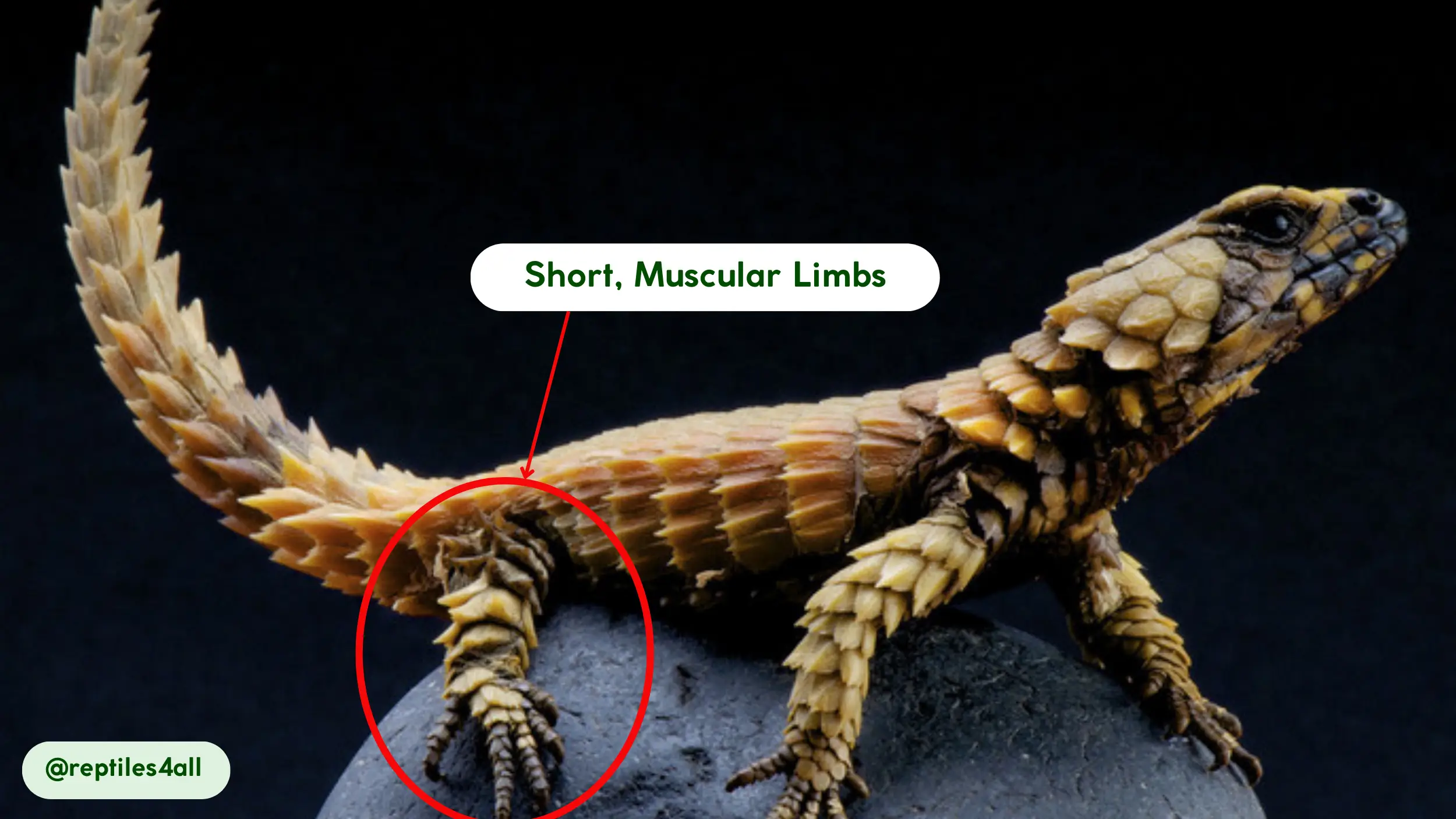
Daily/Seasonal Patterns
Armadillo Lizards are diurnal, meaning they are active during the day [2]. Their daily activity cycle is closely tied to ambient temperature and sunlight. They typically emerge from their burrows in the early morning to bask in the sun and raise their body temperature [2][19].
Once warmed, they begin foraging and socializing. Activity levels peak during the warmest hours of the day, when insects are most prevalent [14]. As the sun sets, they retreat to their rock crevices for protection against the cold night temperatures [2].
Seasonally, their activity is highest in the warmer months, during which they feed and reproduce [2]. In the colder winter months, they enter a state of brumation, becoming largely inactive until temperatures rise again [2][19]. This species is non-migratory and highly sedentary, remaining within a small territory centered around a specific rock den for its entire life [14].
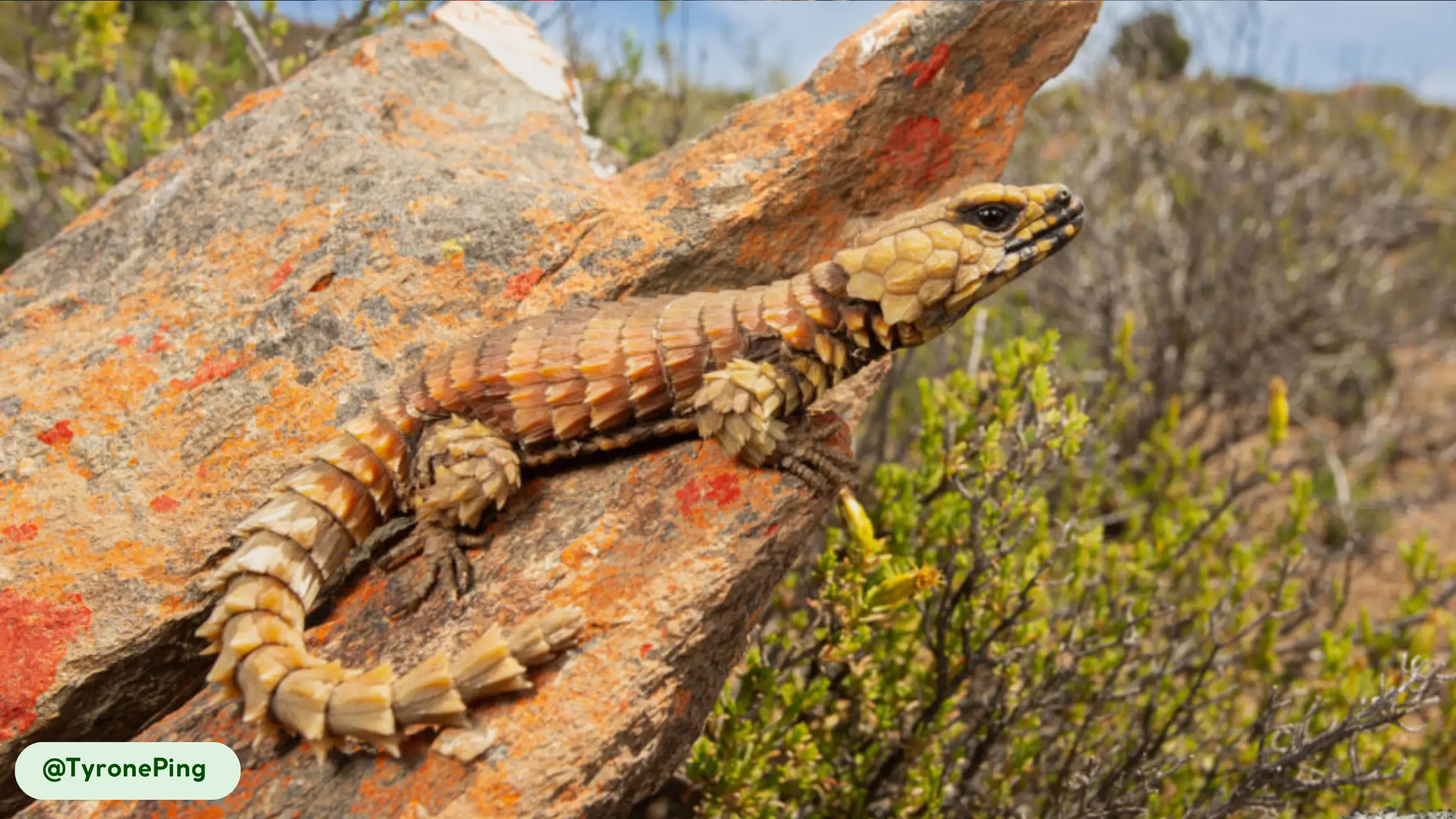
How Do Armadillo Lizards Reproduce?
Armadillo Lizards are a viviparous species, which means they give birth to live young rather than laying eggs [2][19]. This reproductive strategy, which is less common in reptiles, allows the mother to protect the developing embryos from external threats and environmental fluctuations for the entire gestation period [15].
The mating season typically occurs in late spring, during which males engage in courtship rituals that involve territorial displays and biting the female’s neck to initiate copulation [2][19]. After a gestation period of approximately six to eight months, a female gives birth to one or, less commonly, two live offspring [2][19].
A key aspect of their reproductive biology is the extended parental care they provide; mothers will feed and protect their young for several months, a behavior that is unique among many lizard species [2][19].
The journey from a single, fertilized egg to a live birth is a feat for a reptile. The duration of this life cycle, from birth to full maturity, offers a more complete understanding of this animal’s slow but steady progression through life.
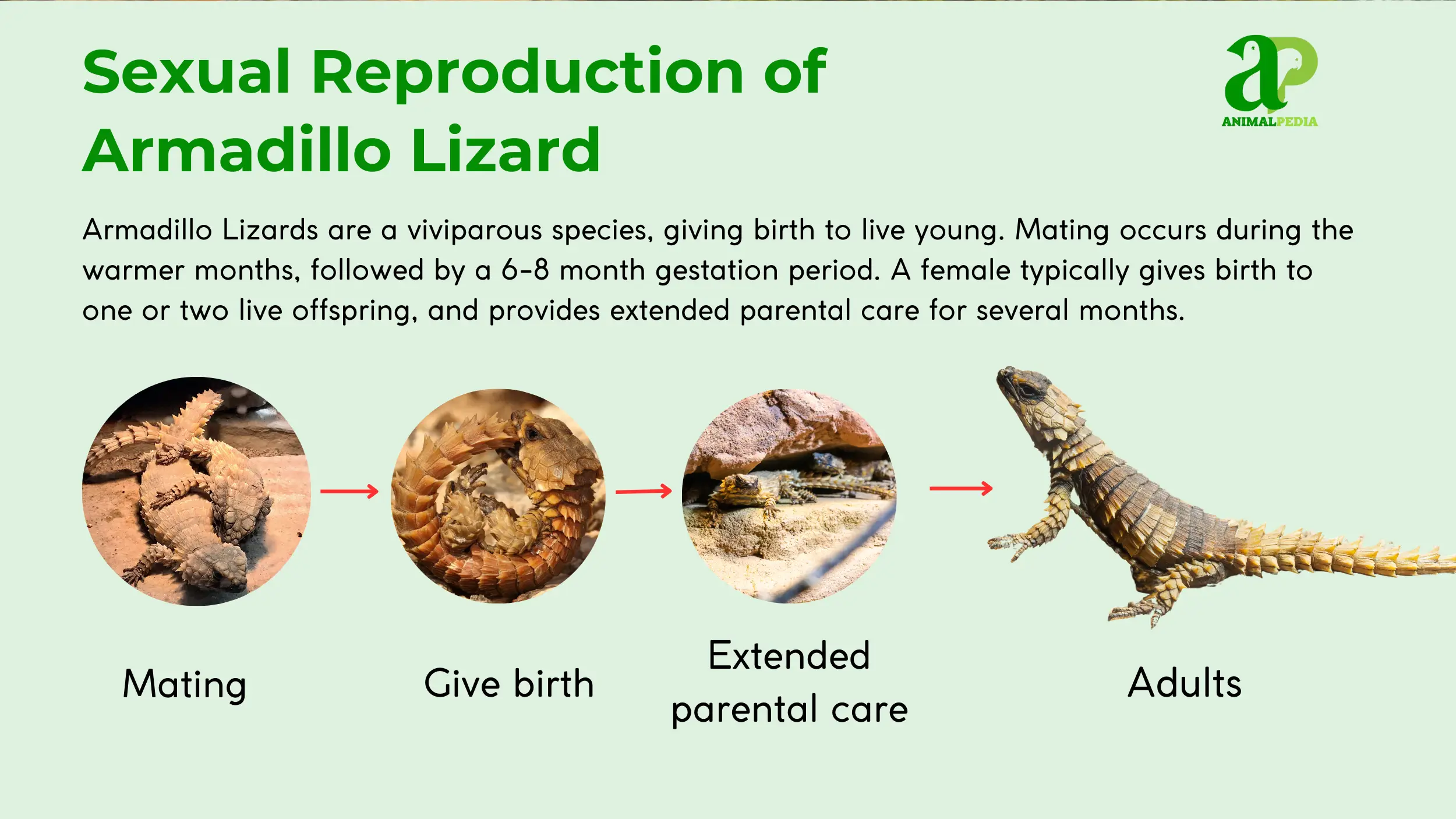
How Long Do Armadillo Lizards Live?
Armadillo lizards live an average of 15 to 20 years in the wild and can reach up to 25 years in captivity [2][19]. Their longevity is influenced by several factors, including habitat quality, food availability, and predation pressure. In their natural, rocky habitat, they face threats from birds of prey, snakes, and other predators, which can limit their lifespan [2][19].
In captivity, these threats are removed, and a controlled environment with consistent access to food and veterinary care allows them to live longer.
Armadillo lizards reach maturity at around 5 to 6 years of age, at which point they are able to reproduce [2][19]. Their long lifespan and slow maturation rate highlight a different life strategy compared to many other reptile species, which often mature quickly and have a shorter lifespan.
The long-term parental care provided by the mothers also contributes to the high survival rate of the young, further supporting this species’ life history strategy [2][19].
The impressive lifespan of the Armadillo Lizard is a clear indicator of its resilience in the wild. But beyond its longevity, the species provides ecological benefits that extend beyond its own survival.
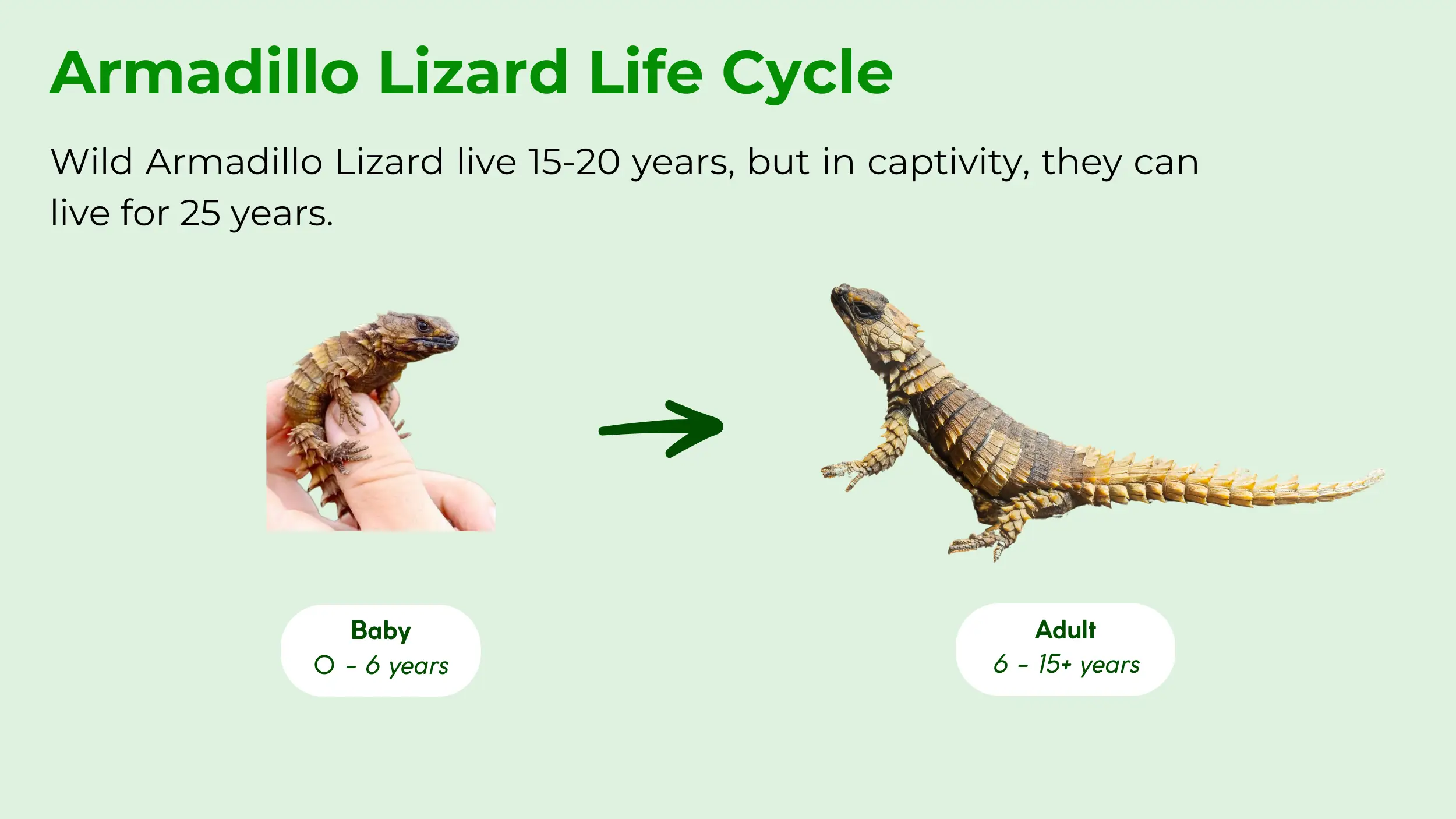
Are Armadillo Lizards Beneficial to Humans?
Armadillo lizards are beneficial components of their native ecosystem. This species is not venomous, and its primary defensive strategy involves a harmless curl, protecting its vulnerable belly from predators rather than attacking people [2]. Ecologically, they provide a valuable service by controlling termite populations, which can cause significant damage to agriculture and infrastructure [2][14].
Their unique appearance and defensive behavior have made them a symbol of protection and have also contributed to their popularity in the pet trade. However, the illegal collection of these reptiles has placed a strain on wild populations, highlighting a negative human impact rather than a harmful characteristic of the species itself [12].
The positive ecological impact of the Armadillo Lizard is a testament to its role in the natural world. This contribution is especially important given the ongoing threats this species faces in its native habitat.
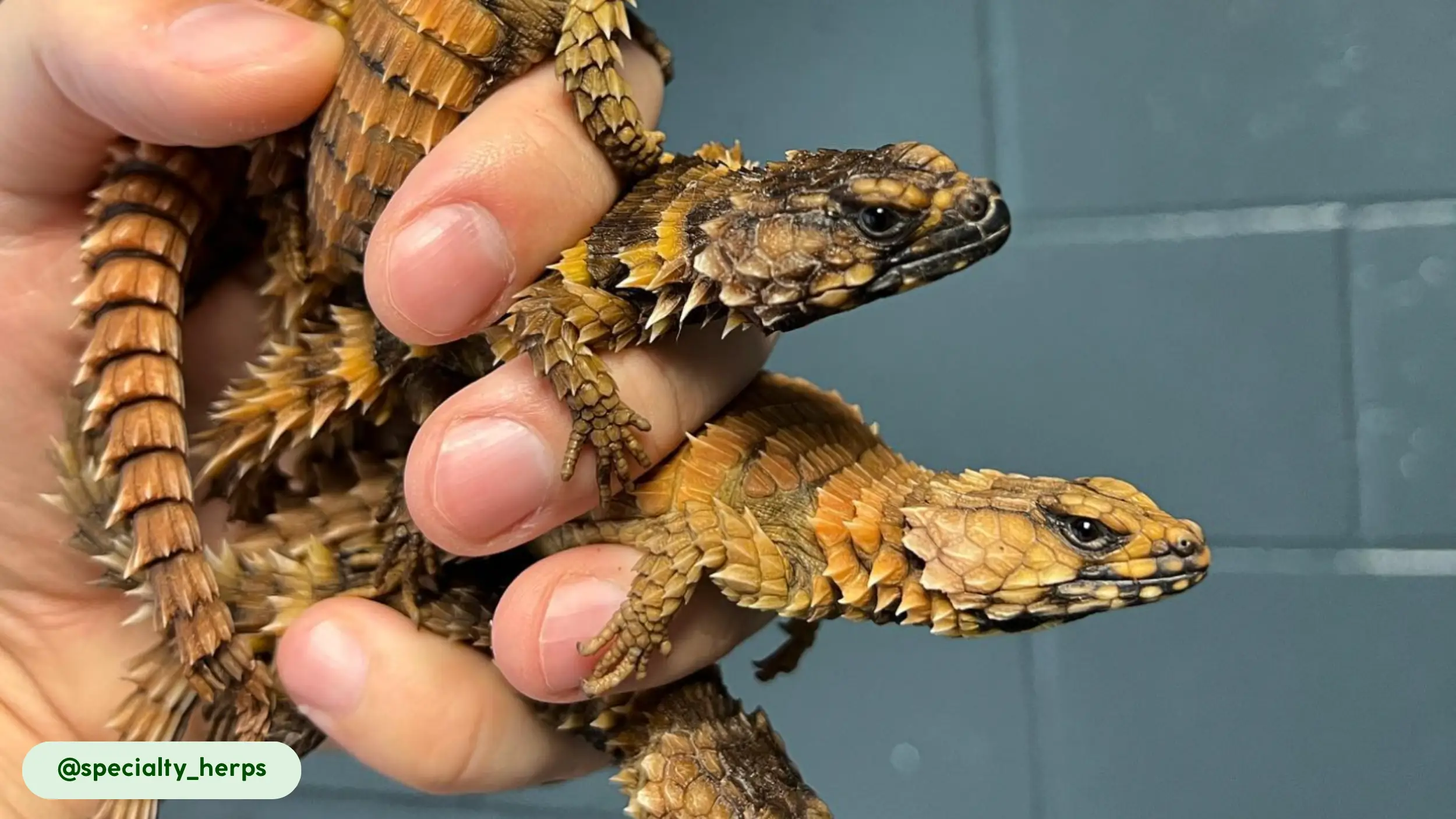
Are Armadillo Lizards Endangered?
Armadillo Lizards are not currently classified as Endangered; however, they are listed as Near Threatened by the International Union for Conservation of Nature (IUCN) Red List of Threatened Species [12]. The primary threats to this species are habitat loss due to development and an increasing demand from the illegal pet trade [12][16].
Their sedentary nature and reliance on specific rocky habitats make them particularly vulnerable to these pressures [14]. The lizards perform a vital ecological service by controlling termite populations, which can impact local ecosystems [2][14].
Individuals can aid in their conservation by supporting organizations focused on protecting their native South African habitat and by refraining from purchasing wild-caught animals [12].
The conservation status of the Armadillo Lizard highlights the urgent need for action to protect this species. To better understand this reptile, we have compiled a collection of exciting facts about Armadillo Lizards.
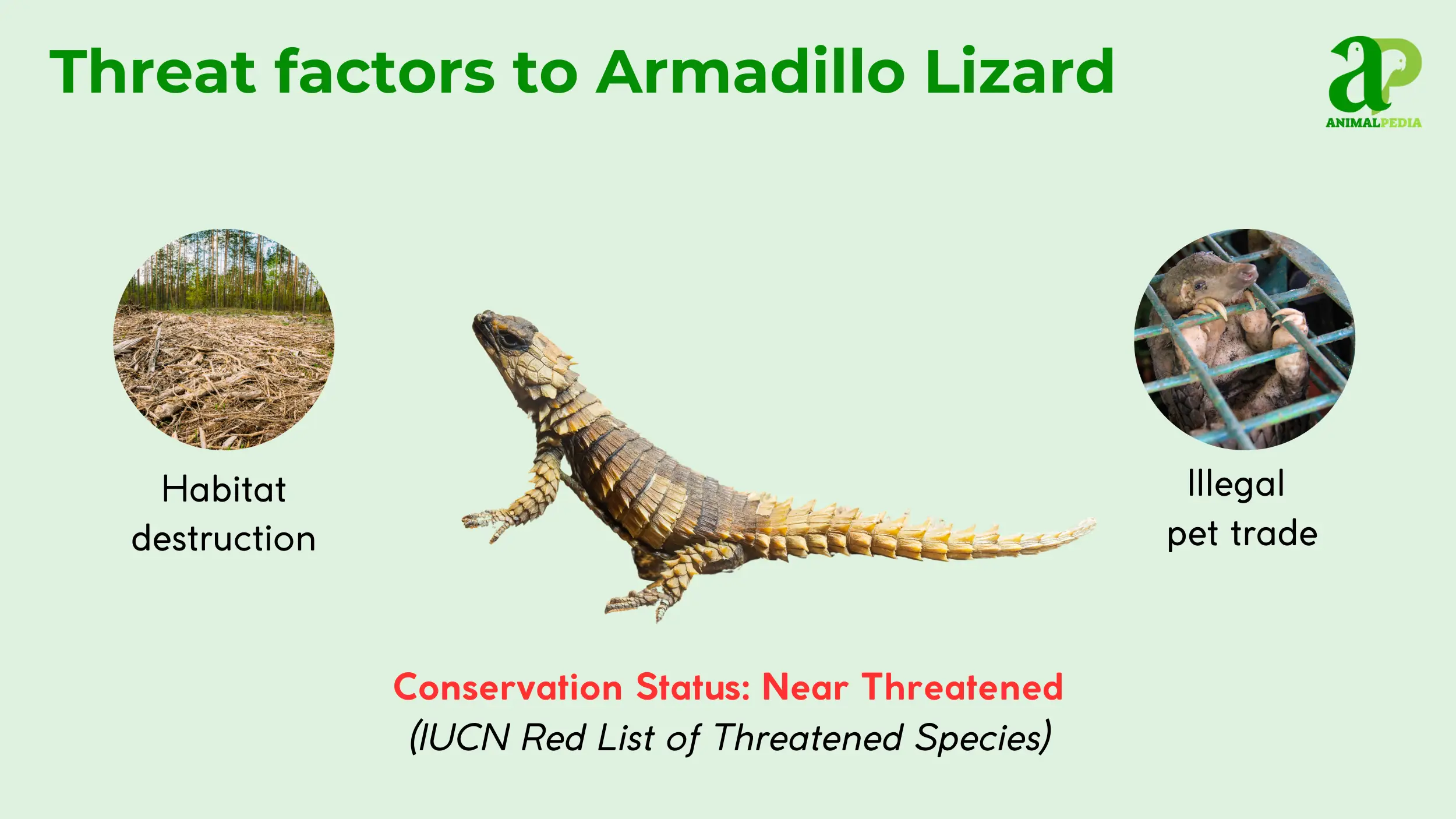
Frequently Asked Questions About House Geckos
Can You Have An Armadillo Lizard As A Pet?
No, it is not advisable to keep an Armadillo Lizard as a pet. It is a CITES Appendix II protected species, making the collection of wild individuals illegal. Their specific care requirements are challenging to meet outside their natural habitat.
Are Armadillo Lizards Dangerous?
No, Armadillo Lizards are not dangerous to humans. They are not venomous, and their primary defensive strategy involves a harmless curl, which protects their vulnerable belly rather than attacking people.
How Long Do Armadillo Lizards Raise Their Young?
Armadillo Lizard mothers provide extended parental care, raising their young for several months after birth. This behavior is unique among many lizard species and significantly contributes to the high survival rate of the offspring.
Why Do Armadillo Girdled Lizards Bite Their Tails?
The lizard bites its tail to form a defensive curl. This posture protects the lizard’s soft, vulnerable underbelly by presenting a tough, spiny ring to any potential predator, making it difficult to grasp or swallow.
How Do Armadillo Lizards Survive In The Desert?
Armadillo Lizards survive in their desert habitat through behavioral and physical adaptations. They retreat to cool, rocky crevices to avoid extreme heat and use their armored scales for protection against both predators and the harsh environment.
What Eats The Armadillo Lizard?
Predators of the Armadillo Lizard include birds of prey, such as eagles and hawks, as well as various species of snakes. The lizard’s armored body and defensive curl are evolved defenses against these specific predators, though they are not always successful.
Conclusion
The Armadillo Lizard, with its armored body and unique defensive curl, stands as a prime example of evolutionary adaptation in a challenging environment. Its social behavior, specialized diet, and extended parental care make it a truly exceptional species.
At Animal Pedia, we are dedicated to providing in-depth, accurate information to foster a deeper understanding of the animal kingdom. Chúng tôi mời bạn tiếp tục khám phá nhiều nội dung hơn trên trang web của chúng tôi và tiếp tục hành trình của mình qua những sinh vật hấp dẫn nhất trên thế giới.

